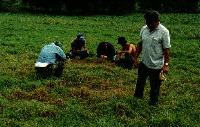E-Mail to HDOA Return to
Hawaii's |
(Sipha flava [Forbes]): This aphid was first found in late 1988 infesting kikuyu grass (Pennisetum clandestinum) in the North Kona district of Hawaii Island. Sipha flava is widely distributed on Gramineae in the New World, from Argentina to the United States and throughout the Caribbean. Recorded hosts include sugarcane, rice, sorghum, lemon grass, barley, wheat, oats, Carimagua grass, pangola grass, crab grass, and finger grass. In Hawaii, it has been reported from all of the main islands except Lanai. The main cause of injury to host plants is from injection of toxic saliva. Leaves of infested kikuyu grass, an important rangeland and forage grass, first yellow, then turn brown and die. Sipha flava is also implicated as a vector of sugarcane mosaic virus. In sugarcane, heavy infestations can destroy an entire planting of young cane or ratoons; yield losses have been reported as high as $155 per acre in particular varieties. An aphidiid wasp, Adialytus ambiguus (Haliday), was collected in France and released on Hawaii in September 1991. The parasitoid has since been recovered in low numbers, parasitization occurring at rates usually below 10%, and is apparently established. Other ecotypes of A. ambiguus, collected from France and Spain, are being cultured in quarantine at the Hawaii Department of Agriculture's insectary in Honolulu. Further releases of the parasitoid were made on Kauai, beginning in late 1991. |
 Yellow sugarcane aphid
Yellow sugarcane aphid